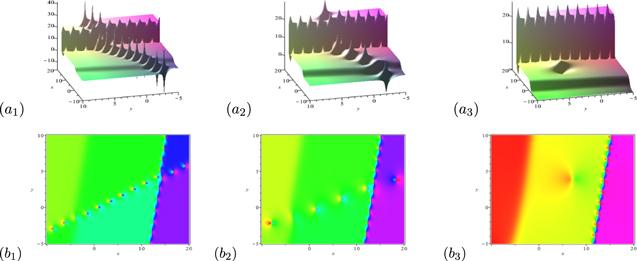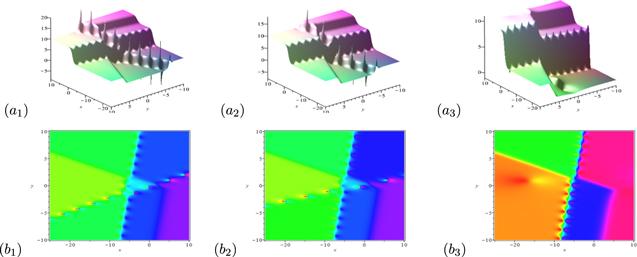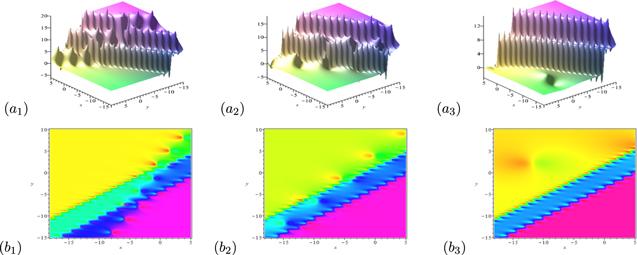 ,, Hongli An
,, Hongli An ,, Peng JinCollege of Sciences,
,, Peng JinCollege of Sciences, Received:2021-08-7Revised:2021-10-10Accepted:2021-10-13Online:2021-11-23

Abstract
Keywords:
PDF (1085KB)MetadataMetricsRelated articlesExportEndNote|Ris|BibtexFavorite
Cite this article
Jiaxin Qi, Hongli An, Peng Jin. Breather molecules and localized interaction solutions in the (2+1)-dimensional BLMP equation. Communications in Theoretical Physics, 2021, 73(12): 125005- doi:10.1088/1572-9494/ac2f2b
1. Introduction
The (2+1)-dimensional Boiti–Leon–Manna–Pempinelli (BLMP) equation under consideration is an adopted form of:Nowadays, investigations into breather molecules is a hot topic. The breather molecule is a special kind of soliton molecule, which displays periodic structure in a certain direction and owns molecule-like behaviors. The latter was originally presented by Akhmediev et al [16] and observed by Stratmann et al in the experiment [17]. Investigations show that soliton molecules have many appealing features and been widely used in plasmas physics, optics, Bose–Einstein condensates and fluid dynamics [18–21]. When a complex conjugate constraint is introduced, the soliton molecule will turn to the breather molecule. The breather molecule has been observed in mode-locked fiber laser experiments [22]. Recently, Lou et al proposed the velocity resonance and module resonance principle and therefore some breather molecules are obtained [23, 24]. The work of Lou's motivates many experts to devote themselves to seeking soliton and breather molecules in various physical models. Up to now, the soliton and breather molecules are constructed for the Sawada–Kotera equation [25], the complex mKdV equation [26], the fifth-order KdV equation [27] and the Sharma–Tasso–Olver–Burgers equation etc [28–30]. Therefore, it would be of interest to seek molecule solutions in other physical models.
Inspections show that no investigations have been carried on breather molecules of the (2+1)-dimensional BLMP equation. Not much work has been done on the interaction solutions of breather-molecule-types. To the best of our knowledge, no work has been carried out on the interactions between a breather molecule or breather-soliton molecule and lumps, yet. We notice that the special form of the BLMP equation makes the long wave limit lose its power to derive the molecule interaction solutions involving lumps. However, such solutions seem to have wider applications in the real world. Therefore, it is worth considering whether alternative methods exist that lead to these solutions.
To summarise, in this paper we would like to investigate the breather molecule and interaction solutions of the the BLMP equation. Our work begins with a logarithmic transformation. Under the transformation, N-soliton solutions of the BLMP equation are constructed. Then, the partial velocity resonance, the module resonance principle and a partial degeneration of the breather technique are employed, thereby the breather molecule, breather-soliton molecule and some hybrid solutions (such as the interactions between a breather molecule and lump, between a breather-soliton molecule and lump etc.) are obtained. We would like to stress that it is the first time using the degeneration method to obtain the interaction solutions between molecules and a lump. To shed light on the dynamical behaviors the solutions may posses, numerical simulations and illustrative tables are given, which indicate that the types of solutions and their features are intimately related to the restricted conditions.
2. N-soliton solutions of the (2+1)-dimensional BLMP equation
In order to obtain the breather molecule and related interaction solutions, we need to construct the N-soliton solutions of the (2+1)-dimensional BLMP equation first. For that purpose, a special transformation is introduced viaAccording to the Hirota bilinear method [31], the N-soliton solutions to the BLMP equation are derived
3. A breather-soliton molecule and some related interaction solutions
In this section, we show that by employing the partial velocity resonance principle and module resonance of two waves, a breather-soliton molecule and four kinds of interactions solutions are obtained. Interestingly, when the partial degeneration of the breather technique is additionally adopted, two new kinds of resonant solutions mixed by a breather-soliton molecule and a lump as well as a bell-shaped soliton and a lump are derived. We emphasize that due to the special form of the BLMP equation, the long wave limit loses its power. Therefore, it is the first time to use the degeneration of breathers to generate the interaction molecule solutions involving a lump.To construct the breather-soliton molecule and interaction solutions, we need to set N = 3 + P (P = 0, 1, ⋯). On imposing the complex conjugate constraints to {ki, pi} (i = 1, 2):
Case 1: Considering P = 0. When insertion of (
Figure 1.
 New window|Download| PPT slide
New window|Download| PPT slideFigure 1.Dynamical behaviors of the breather-soliton molecule. The parameters are given by k1r = 1.56, k1i = 0.25, k3 = 1.5, p1r = 0.5, p1i = 4.68, p3 = −0.25.
Case 2: Taking P = 1. OBy making similar analysis to Case 1, one can derive an interaction solution mixed by a breather-soliton molecule and a bell-shaped soliton ({BSM, S}). It is necessary to point out that: the {BSM, S} described in figure 2 exhibits quite different dynamical behaviors to the {BSM} given in figure 1, although the same techniques are used. Figure 2 shows that the breather parallels to one of the solitons (labelled as 3rd-soliton) to form the breather-soliton molecule and then interacts with the other soliton (labelled as 4th-soliton). Unlike Case 1, the distance between the breather-soliton and the 4th-soliton changes over time. Therefore, the interactions of the {BSM, S} are inelastic.
Figure 2.
 New window|Download| PPT slide
New window|Download| PPT slideFigure 2.Dynamical behaviors of the hybrid solution between a breather-soliton and a bell-shaped soliton. The parameters are chosen as ${k}_{1r}=\sqrt{7}$, k1i = 1, k3 = 2, k4 = 2, ${p}_{1r}=\tfrac{1}{2}$, ${p}_{1i}=\tfrac{3\sqrt{7}}{4}$, ${p}_{3}=-\tfrac{1}{4}$, p4 = 4.
Case 3: Setting P = 2. If we additionally impose the complex conjugate conditions to the parameters {ki, pi}(i = 4, 5) via
Figure 3.
 New window|Download| PPT slide
New window|Download| PPT slideFigure 3.Dynamical behaviors of the hybrid solution mixed by a breather-soliton molecule and breather.
In [32], it is revealed that a partial degeneration of the breather can lead to a lump. Here, we shall combine the degeneration technique with the module resonance principle to construct the interaction solution mixed by a breather-soliton molecule and lump. Thus, we need to know the periodicity of the related breather first.
Calculations show that the periodicity of the 2nd-breather along the x direction is ${T}_{[x]}=| \tfrac{2\pi ({p}_{4r}{k}_{4r}-{p}_{4i}{k}_{4i})}{{p}_{4i}({k}_{4r}^{2}+{k}_{4i}^{2})}| $ and the periodicity along the y direction is ${T}_{[y]}=| \tfrac{2\pi {k}_{4r}}{{p}_{4i}({k}_{4r}^{2}+{k}_{4i}^{2})}| $. Therefore, the composite periodicity of the 2nd-breather is:
Figure 4.
 New window|Download| PPT slide
New window|Download| PPT slideFigure 4.The degeneration process of the solution mixed by a breather-soliton molecule and lump from {BSM, B}. The parameters are chosen as flows: k1r = 4, k1i = 2, k3 = 2, p1r = 0.17, p1i = 0.83, p3 = − 0.25, p4r = 0.03, p4i = 1.5. (a1)(b1) k4r = 1, k4i = 2; (a2)(b2) ${k}_{4r}=\tfrac{2}{5}$, k4i = 1; (a3)(b3) ${k}_{4r}=\tfrac{1}{5}$, ${k}_{4i}=\tfrac{1}{8}$.
Case 4: When P = 3, if we only require a pair of complex conjugate conditions (
Figure 5.
 New window|Download| PPT slide
New window|Download| PPT slideFigure 5.Dynamical behaviors of the interaction solution composed by a breather-soliton molecule, a breather and a soliton. The parameters are selected as k1r = 1.32, k1i = 0.25, k3 = 1.5, k4r = 1.73, k4i = 0.5, k6 = 1.5, p1r = 0.5, p1i = 3.17, p3 = −0.25, p4r = 0.33, p4i =2.02, p6 = 4.
Figure 6.
 New window|Download| PPT slide
New window|Download| PPT slideFigure 6.The degeneration process of the solution mixed by a breather-soliton molecule, a lump and a soliton from {BSM, B, S}. The parameters are chosen as flows: k1r = 1.732, k1i = 0.5, k3 = 1.5, p1r = 0.33, p1i = 2.02, p3 = −0.25, p4r = 0.08, p4i = 4, k6 = 1.5, p6 = 4. (a1)(b1) k4r = 0.8, k4i = 0.8; (a2)(b2) k4r = 0.5, k4i = 0.8; (a3)(b3) k4r = 0.02, k4i = 0.2.
Interestingly, if we set the additional P solitons to satisfy the module resonance principle via
Figure 7.
 New window|Download| PPT slide
New window|Download| PPT slideFigure 7.Dynamical behaviors of the interaction solution mixed by two different breather-soliton molecules. The parameters are given by k1r = 1.32, k1i = 0.25, k3 = 1.5, k4r = 1.73, k4i = 0.5, k6 = 1.25, p1r = 0.5, p1i = 3.17, p3 = −0.25, p4r = 0.33, p4i = 2.02, p6 = −0.1.
Now, we give the related mathematical features in order to obtain the breather-soliton molecule and interaction solutions when N = 3 + P. Details are given in table 1. The first column in the table describes the numbers of N and P. While the second and third columns show the types of the solutions and corresponding different parameters as well as restricted conditions.
Table 1.
Table 1.Breather-soliton molecule and interaction solutions.
| N = 3 + P | Name of the solution | Restriction conditions |
|---|---|---|
| P = 0 | {BSM} | ${k}_{1}={k}_{2}^{* }={k}_{1r}+{\rm{i}}{k}_{1i},\quad {p}_{1}={p}_{2}^{* }\,=\,{p}_{1r}+{\rm{i}}{p}_{1i}$, |
| $\tfrac{{k}_{1r}}{{k}_{3}}=\tfrac{{k}_{1r}\ {p}_{1r}-{k}_{1i}\ {p}_{1i}}{{k}_{3}\ {p}_{3}}=\tfrac{{k}_{1r}^{3}-3{k}_{1r}\ {k}_{1i}^{2}}{{k}_{3}^{3}}$ | ||
| P = 1 | {BSM, S} | the same as above |
| P = 2 | {BSM, B} | ${k}_{1}={k}_{2}^{* }={k}_{1r}+{\rm{i}}{k}_{1i},\quad {p}_{1}={p}_{2}^{* }\,=\,{p}_{1r}+{\rm{i}}{p}_{1i}$, |
| ${k}_{4}={k}_{5}^{* }={k}_{4r}+{\rm{i}}{k}_{4i},\quad {p}_{4}={p}_{5}^{* }={p}_{4r}+{\rm{i}}{p}_{4i}$ | ||
| $\tfrac{{k}_{1r}}{{k}_{3}}=\tfrac{{k}_{1r}\ {p}_{1r}-{k}_{1i}\ {p}_{1i}}{{k}_{3}\ {p}_{3}}=\tfrac{{k}_{1r}^{3}-3{k}_{1r}\ {k}_{1i}^{2}}{{k}_{3}^{3}}$, | ||
| P = 2 | {BSM, L} | ${k}_{1}={k}_{2}^{* }={k}_{1r}+{\rm{i}}{k}_{1i},\quad {p}_{1}={p}_{2}^{* }\,=\,{p}_{1r}+{\rm{i}}{p}_{1i}$, |
| ${k}_{4}={k}_{5}^{* }={k}_{4r}+{\rm{i}}{k}_{4i},\quad {p}_{4}={p}_{5}^{* }={p}_{4r}+{\rm{i}}{p}_{4i}$, | ||
| $\tfrac{{k}_{1r}}{{k}_{3}}=\tfrac{{k}_{1r}\ {p}_{1r}-{k}_{1i}\ {p}_{1i}}{{k}_{3}\ {p}_{3}}=\tfrac{{k}_{1r}^{3}-3{k}_{1r}\ {k}_{1i}^{2}}{{k}_{3}^{3}}$, | ||
| ${k}_{4r}^{2}+{k}_{4i}^{2}\to 0$ | ||
| P = 3 | {BSM, B, S} | the same as what's used in {BSM, B} |
| P = 3 | {BSM, L, S} | the same as what's used in {BSM, L} |
| P = 3 | {BSM, BSM} | ${k}_{1}={k}_{2}^{* }={k}_{1r}+{\rm{i}}{k}_{1i},\quad {p}_{1}={p}_{2}^{* }\,=\,{p}_{1r}+{\rm{i}}{p}_{1i}$, |
| ${k}_{4}={k}_{5}^{* }={k}_{4r}+{\rm{i}}{k}_{4i},\quad {p}_{4}={p}_{5}^{* }\,=\,{p}_{4r}+{\rm{i}}{p}_{4i}$, | ||
| $\tfrac{{k}_{1r}}{{k}_{3}}=\tfrac{{k}_{1r}\ {p}_{1r}-{k}_{1i}\ {p}_{1i}}{{k}_{3}\ {p}_{3}}=\tfrac{{k}_{1r}^{3}-3{k}_{1r}\ {k}_{1i}^{2}}\ {{k}_{3}^{3}}$, | ||
| $\tfrac{{k}_{4r}}{{k}_{6}}=\tfrac{{k}_{4r}\ {p}_{4r}-{k}_{4i}\ {p}_{4i}}{{k}_{6}\ {p}_{6}}=\tfrac{{k}_{4r}^{3}-3{k}_{4r}\ {k}_{4i}^{2}}{{k}_{6}^{3}}$ |
New window|CSV
4. A breather molecule and some related interaction solutions
In this section, by using the module resonance of four waves and partial degeneration of breather techniques, a breather molecule and five different resonant solutions are derived. Their dynamical behaviors and mathematical features are discussed.To obtain the breather molecule and related interaction solutions, it requires to set N = 4 + P. Meanwhile, two pairs of solitons need to satisfy the conjugate constraints:
Case 1: Taking P = 0. On substituting (
Figure 8.
 New window|Download| PPT slide
New window|Download| PPT slideFigure 8.Dynamical behaviors of the breather molecule. The parameters are set as k1r = 1.73, k1i = 1.25, k3r = 1.39, k3i = 1.10, p1r = 0.73, p1i = 3, p3r = 0.73 and p3i = 2.73.
Case 2: Considering P = 1. When adopting the analogous technique mentioned in the above to the five-solitons, we obtain an interaction solution mixed by a breather molecule and a bell-shaped soliton ({BBM, S}). Dynamical behaviors of their interactions are traced in figure 9.
Figure 9.
 New window|Download| PPT slide
New window|Download| PPT slideFigure 9.Dynamical behaviors of the mixed solution by a breather molecule and soliton. The parameters are set as k1r = 1.73, k1i = 1.25, k3r = 1.39, k3i = 1.10, k5 = 2, p1r = 0.73, p1i = 3, p3r = 0.73 , p3i = 2.73 and p5 = 3.23.
Case 3: Considering P = 2. When the following complex conjugate restriction is introduced via
Figure 10.
 New window|Download| PPT slide
New window|Download| PPT slideFigure 10.Dynamical behaviors of the interaction solution between a breather molecule and breather. The parameters are chosen as: k1 = 1.73 + 1.25i, k3 = 1.39 + 1.10i, k5 = 1.04 + 0.6i, p1 = 0.73 + 3i, p3 = 0.73 + 2.73i, p5 = 0.73 + 2.73i.
Remarkably, we note that if we also require the breather molecule and the 3rd-breather to satisfy the resonance principle given by:
Figure 11.
 New window|Download| PPT slide
New window|Download| PPT slideFigure 11.Dynamical behaviors of a breather-breather-breather molecule. The parameters are chosen as:k1 = 1.73 + 1.25i, k3 = 1.39 + 1.10i, k5 = 1.04 + 0.96i, p1 = 0.73 + 3i, p3 = 0.73 + 1.73i, p5 = 0.73 + 2.34i.
Otherwise, we turn to the solution of {BBM, B}, in which the 3rd-breather satisfies the complex conjugate condition given in (
Figure 12.
 New window|Download| PPT slide
New window|Download| PPT slideFigure 12.The degeneration process of the solution mixed by a breather molecule and lump from {BB, B}. The parameters are chosen as flows: k1r = 1.73, k1i = 1.25, k3r = 1.39, k3i = 1.10, p1r = 0.73, p1i = 3, p3r = 0.73, p3i = 2.73, p5r = 0.15, p5i = 1.5. (a1)(b1) k5r = 1, k5i = 0.6; (a2)(b2) k5r = 0.5, k5i = 0.4; (a3)(b3) k5r = 0.1, k5i = 0.3.
Now, we summarize some restriction conditions to obtain the breather molecule and various interaction solutions when N = 4 + P. Details can be seen in table 2.
Table 2.
Table 2.Breather molecule and interaction solutions.
| N = 4 + P | Name of the solution | Restriction conditions |
|---|---|---|
| P = 0 | {BBM} | ${k}_{1}={k}_{2}^{* }={k}_{1r}+{\rm{i}}{k}_{1i},\quad {p}_{1}={p}_{2}^{* }\,=\,{p}_{1r}+{\rm{i}}{p}_{1i}$, |
| ${k}_{3}={k}_{4}^{* }={k}_{3r}+{\rm{i}}{k}_{3i},\quad {p}_{3}={p}_{4}^{* }={p}_{3r}+{\rm{i}}{p}_{3i}$, | ||
| $\tfrac{{k}_{1r}}{{k}_{3r}}=\tfrac{{k}_{1r}\ {p}_{1r}-{k}_{1i}\ {p}_{1i}}{{k}_{3r}\ {p}_{3r}-{k}_{3i}\ {p}_{3i}}=\tfrac{{k}_{1r}^{3}-3{k}_{1r}\ {k}_{1i}^{2}}{{k}_{3r}^{3}-3{k}_{3r}\ {k}_{3i}^{2}}$ | ||
| P = 1 | {BBM, S} | the same as above |
| P = 2 | {BBM, B} | ${k}_{1}={k}_{2}^{* }={k}_{1r}+{\rm{i}}{k}_{1i},\quad {p}_{1}={p}_{2}^{* }\,=\,{p}_{1r}+{\rm{i}}{p}_{1i}$, |
| ${k}_{3}={k}_{4}^{* }={k}_{3r}+{\rm{i}}{k}_{3i},\quad {p}_{3}={p}_{4}^{* }={p}_{3r}+{\rm{i}}{p}_{3i}$, | ||
| $\tfrac{{k}_{1r}}{{k}_{3r}}=\tfrac{{k}_{1r}\ {p}_{1r}-{k}_{1i}\ {p}_{1i}}{{k}_{3r}\ {p}_{3r}-{k}_{3i}\ {p}_{3i}}=\tfrac{{k}_{1r}^{3}-3{k}_{1r}\ {k}_{1i}^{2}}{{k}_{3r}^{3}-3{k}_{3r}\ {k}_{3i}^{2}}$, | ||
| ${k}_{5}={k}_{6}^{* }={k}_{5r}+{\rm{i}}{k}_{5i},\quad {p}_{5}={p}_{6}^{* }={p}_{5r}+{\rm{i}}{p}_{5i}$ | ||
| P = 2 | {BBM, L} | ${k}_{1}={k}_{2}^{* }={k}_{1r}+{\rm{i}}{k}_{1i},\quad {p}_{1}={p}_{2}^{* }\,=\,{p}_{1r}+{\rm{i}}{p}_{1i}$, |
| ${k}_{3}={k}_{4}^{* }={k}_{3r}+{\rm{i}}{k}_{3i},\quad {p}_{3}={p}_{4}^{* }={p}_{3r}+{\rm{i}}{p}_{3i}$, | ||
| ${k}_{5}={k}_{6}^{* }={k}_{5r}+{\rm{i}}{k}_{5i},\quad {p}_{5}={p}_{6}^{* }={p}_{5r}+{\rm{i}}{p}_{5i},$ | ||
| $\tfrac{{k}_{1r}}{{k}_{3r}}=\tfrac{{k}_{1r}\ {p}_{1r}-{k}_{1i}\ {p}_{1i}}{{k}_{3r}\ {p}_{3r}-{k}_{3i}\ {p}_{3i}}=\tfrac{{k}_{1r}^{3}-3{k}_{1r}\ {k}_{1i}^{2}}{{k}_{3r}^{3}-3{k}_{3r}\ {k}_{3i}^{2}}$, | ||
| ${k}_{5r}^{2}+{k}_{5i}^{2}\to 0$ | ||
| P = 2 | {BBBM} | ${k}_{1}={k}_{2}^{* }={k}_{1r}+{\rm{i}}{k}_{1i},\quad {p}_{1}={p}_{2}^{* }\,=\,{p}_{1r}+{\rm{i}}{p}_{1i}$, |
| ${k}_{3}={k}_{4}^{* }={k}_{3r}+{\rm{i}}{k}_{3i},\quad {p}_{3}={p}_{4}^{* }={p}_{3r}+{\rm{i}}{p}_{3i}$, | ||
| ${k}_{5}={k}_{6}^{* }={k}_{5r}+{\rm{i}}{k}_{5i},\quad {p}_{5}={p}_{6}^{* }={p}_{5r}+{\rm{i}}{p}_{5i}$, | ||
| $\tfrac{{k}_{1r}}{{k}_{3r}}=\tfrac{{k}_{1r}\ {p}_{1r}-{k}_{1i}\ {p}_{1i}}{{k}_{3r}\ {p}_{3r}-{k}_{3i}\ {p}_{3i}}=\tfrac{{k}_{1r}^{3}-3{k}_{1r}\ {k}_{1i}^{2}}{{k}_{3r}^{3}-3{k}_{3r}\ {k}_{3i}^{2}}$, | ||
| $\tfrac{{k}_{1r}}{{k}_{5r}}=\tfrac{{k}_{1r}\ {p}_{1r}-{k}_{1i}\ {p}_{1i}}{{k}_{5r}\ {p}_{5r}-{k}_{5i}\ {p}_{5i}}=\tfrac{{k}_{1r}^{3}-3{k}_{1r}\ {k}_{1i}^{2}}{{k}_{5r}^{3}-3{k}_{5r}\ {k}_{5i}^{2}}$ |
New window|CSV
5. Conclusion
In recent years, investigating the breather molecules and soliton molecules, which has been widely used in plasmas physics, optics, Bose–Einstein condensates and fluid dynamics, is a very popular topic. In this paper, we construct the breather molecule, breather-soliton molecule and many related interactions solutions of the BLMP equation. In particular, by using the technique composed by the partial velocity resonance, the module resonance and degenerating the breather, we derive the hybrid solutions mixed by a breather molecule/breather-soliton molecule and a lump/breather/a lump and a bell-shaped soliton. All these solutions, especially the interactions involving lumps are completely new and interesting. Their dynamical behaviors and mathematical structures are discussed in detail. It is necessary to point out that the compound degeneration method introduced here can be effectively used to investigate the interaction solutions involving lumps of nonlinear systems. Based on the importance and wide applications of the breather molecule and the BLMP equation, we hope that such solutions can be helpful for understanding and studying the propagations of nonlinear localized waves.Acknowledgments
This work is supported by the National Natural Science Foundation of China under Grant No. 11 775 116 and Jiangsu Qinglan high-level talent Project.Reference By original order
By published year
By cited within times
By Impact factor
[Cited within: 1]
DOI:10.1016/j.physleta.2011.01.009 [Cited within: 1]
DOI:10.1016/S0375-9601(03)00873-9 [Cited within: 1]
DOI:10.1142/S021797920803954X [Cited within: 1]
DOI:10.1007/s11071-015-1986-4 [Cited within: 1]
DOI:10.1088/1402-4896/ab7fee [Cited within: 1]
DOI:10.1088/1572-9494/abda17 [Cited within: 1]
DOI:10.1088/1572-9494/abbbd8 [Cited within: 1]
DOI:10.1142/S0217984919503767 [Cited within: 1]
DOI:10.1007/s11071-018-4548-8
DOI:10.1016/j.aml.2019.106109
DOI:10.1016/j.camwa.2018.10.008
DOI:10.1007/s11071-020-05573-y [Cited within: 1]
DOI:10.1063/1.1286263 [Cited within: 1]
DOI:10.1103/PhysRevLett.95.143902 [Cited within: 1]
DOI:10.1103/PhysRevLett.15.240 [Cited within: 1]
DOI:10.1038/nphoton.2014.220
DOI:10.1103/PhysRevA.86.013610
DOI:10.1103/RevModPhys.61.763 [Cited within: 1]
DOI:10.1103/PhysRevLett.122.084101 [Cited within: 1]
[Cited within: 1]
DOI:10.1007/s11071-020-05695-3 [Cited within: 1]
DOI:10.1088/1572-9494/ab6184 [Cited within: 1]
DOI:10.1007/s11071-020-05570-1 [Cited within: 1]
DOI:10.1016/j.cnsns.2020.105425 [Cited within: 1]
DOI:10.1016/j.aml.2020.106271 [Cited within: 1]
DOI:10.1088/0256-307X/37/3/030501
DOI:10.1140/epjp/s13360-021-01099-3 [Cited within: 1]
DOI:10.1016/0375-9601(81)90423-0 [Cited within: 1]
DOI:10.1016/j.cnsns.2019.105027 [Cited within: 1]
